top of page

SIRI - Third City of Delhi (1290 - 1320)
 Ruins of Siri FortThe construction of the fort began with the building of a water reservoir for the residents of Siri, a medieval city founded by Alauddin, where the current day fort resides. In Urdu, Hauz means 'tank', and Khas means 'royal', giving the name 'Royal Tank' to the structure. In the 13th century, Firoz Shah Tuqlak, a Muslim emperor from the Tughlaq dynasty, restored the water body and built the fort around it. |
|---|
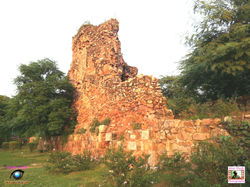 Ruins of Siri FortDuring the rule of Feroz Shah, the city was known as Ferozabad. He was a great ruler and was known for achieving mastery over arts and innovative ideas. Thus he used his innovative skills in designing monuments with his unique architectural styles. |
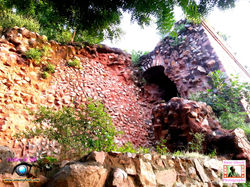 Ruins of Siri FortThe fort is the heart of Siri, the Third of the seven cities of medieval Delhi built around 1303 during the rule of Ala-ud-Din Khilji of the Delhi Sultanate to defend his empire from the attack of the Mongols. Some suggest that the heads of approximately 8,000 Mongol soldiers were taken and others say that the Mongol defeatists were taken to Siri & trampled upon by elephants on the orders of the Khilji ruler. |
 An Unknown tomb |
 Chor MinarChor Minar or the tower of thieves, is a 13th-century minaret with 225 holes, built and constructed under the rule of Alauddin Khilji of the Khilji dynasty and resembles a combination of Parsi and Indian architectural style. According to local legends, during the reign of Alauddin Khilji, severed heads of thieves were displayed and exhibited on spear through its 225 holes, to act as a deterrent. Serving it a nickname- “the tower of beheading”. |
 Mosque at the Northern Tower of the MadrasaThe mosque lies at the northernmost end of the eastern arm of the connected madrasa buildings. The mosque can be entered from the southeast side through a domed gateway |
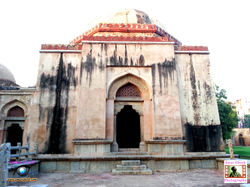 Firoz Shah's TombFiroz Shah, who established the tomb, ascended the throne in 1351 when he was middle aged, as the third ruler of the Tughlaq dynasty and ruled till 1388. There are four graves inside the tomb, one is of Feroz Shah and two others are of his son and grandson |
 Firoz Shah's TombThere are four graves inside the tomb, one is of Feruz Shah and two others are of his son and grandson |
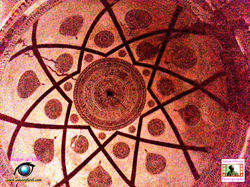 Firoz Shah's TombThe intrados and ceiling of the dome are embellished with colored bands that intersect each other. The squinches are decorated with plasterwork including incised calligraphy. The designs have been incised and gorgeously painted in dark red, green and turquoise. The medallions, Quranic verses, and floral designs combine to describe paradise. |
 Firoz Shah's TombThe tomb, a square chamber, is made of local quartzite rubble with a surface plaster finish that sparkled in white colour when completed. The door, pillars and lintels were made of grey quartzites while red sandstone was used for carvings of the battlements. The door way depicts a blend of Indian and Islamic architecture |
 MadrasaEstablished in 1352, the Madrasa was one of the leading institutions of Islamic learning in the Delhi Sultanate. It was also considered the largest and best equipped Islamic seminary anywhere in the world. |
 Students’ cells at the Hauz Khas madarsa.The Madrasa structure has an innovative design. It was built in L-Shape as one contiguous structure on the south and east edges of the reservoir complex. One arm of the L-shape structure runs in the North–South direction measuring 76 m (249.3 ft) and the other arm runs in the East–West direction measuring 138 m (452.8 ft). |
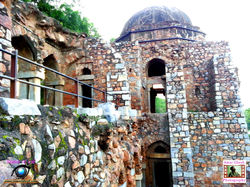 MadrasaFrom each floor of the Madrasa, staircases are provided to go down to the lake. Many cenotaphs, in the form of octagonal and square chhatris are also seen, which are reported to be possibly tombs of teachers of the Madrasa. |
 MadrasaThe madarsa at Hauz Khas consisted of both classrooms (on the ground floor) and living accommodation for students (on the floor below), as well as for teachers. |
 MadrasaAssembly halls and small pavilions where smaller groups could sit dotted the area outside the buildings. These buildings—made mostly of hard grey Delhi quartzite stone—look mostly functional now, but were described by contemporary travellers as being beautifully painted and with golden domes. Fruit trees and gardens of flowers surrounded the buildings in the complex. |
 A stair leading from the water tank to the madarsa. |
 Three pavilions inside the Tomb precincts with a small Chhatri in the foreground |
Among the six rulers of the Khilji dynasty, Allauddin Khilji is the most well known who extended his dominion down southern India too, and created the third city of Delhi, Siri. The Saljuqian influences from West Asia are the most remarkable feature in the buildings from this period. A large reservoir called Hauz Khas was another accomplishment of city of Siri. A madrasa (college) was also created here by later rulers. Hauz Khas today is a complex against the ruins of the ancient SIRI fort.
bottom of page